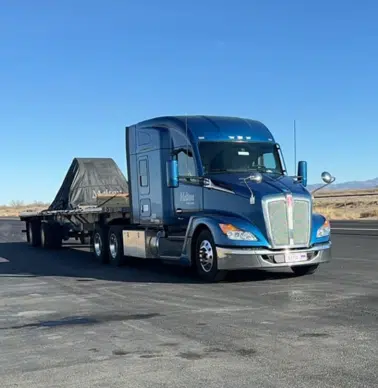
5 Skills Every New Flatbed Driver Should Know
Taking on a job in the trucking industry can come with unique and rewarding career opportunities, but it can also raise some distinct challenges and responsibilities.
New drivers beginning their flatbed careers need to master specific skills to ensure their safety, protect their cargo, and comply with industry standards. Here, we’ll cover the top 5 skills that all flatbed drivers should know.
1. Load Securement
Proper load securement is a fundamental aspect of flatbed trucking. Unlike enclosed trailers, flatbeds loads are exposed to the elements and susceptible to shifting if not securement properly.
Multiple factors are involved in safe load securement, all of which require a keen eye to ensure safety on the road and maintaining the integrity of the load:
- Understanding Securement Equipment: Familiarizing yourself with essential tools like straps, chains, edge protectors and tarps, and when/where each piece is appropriate.
- Load Placement: Distributing the weight evenly across the flatbed to maintain vehicle balance and compliance with safety standards, some loads will even require strategic placement to prevent load shifts.
- Securing Different Types of Cargo: Flatbed loads can vary from lumber and steel coils to heavy machinery and prefabricated buildings, each requiring their own specific securement method.
- Tarping: Whether it’s requested by the customer, or required by state law, many loads will require tarping on top of the securement, providing an additional layer of protection against the elements. Some loads may require specific kinds of tarps, or to be tarped in a certain way.
- Regular Checks: Checking on a load throughout your route is recommended regardless of the trailer type. For flatbed drivers, it’s recommended that checks be conducted routinely every 200 miles, or during travel stops. Knowing when to adjust straps and chains, especially during extreme weather, is absolutely necessary.
2. Navigating Regulations and Compliance
Navigating things like hours of service, permits, and electronic logs are items that many in the trucking industry will have to deal with, but flatbed truck drivers must also navigate a maze of additional regulations to avoid fines, delays, or accidents.
Understanding and adhering to these rules is as important as mastering the physical aspects of the job. Some specific regulations that apply to flatbed drivers:

- State-Specific Laws: If your load takes you across state lines, it’s important to know some states prohibit flatbeds from driving on certain roads, regardless of the load. Some loads may also be required to travel during specific times, or on routes that may not have been previously planned.
- Weight Limits: Depending on the load, roads that are taken by average truck drivers may not be accessible to flatbed drivers due to the load weight. Additionally, some states may change weight limits during certain times of the year, which can impact flatbed drivers that don’t carry specific loads regularly.
- Permits: Flatbed loads will always require additional permits, though they are normally handled during the booking process. For loads that reach the oversized or overweight category, additional permits may be required for each state that the load rolls through. Some states may also require additional signage, pilot cars, and even confirmation with local officials and law enforcement if your route takes you through a certain town.
3. Route Planning Skills
Efficient route planning is critical for timely deliveries and fuel efficiency. It also helps minimize risks and unnecessary stress.
During pre-trip planning, a route plan may be provided for you, but it can also leave out key details as well as back up options in case one leg of the trip should be unavailable. It’s important for drivers to be able to review their routes and ensure that each leg of their journey will be safe, and also comply with regulations.
- Understand Load-Specific Requirements: Does your load meet local bridge height requirements? Will you be able to cross bridges without worry of tonnage or size?
- Plan Rest Stops and Inspection Breaks: Some routes will come with suggestions for gas stations geared for trucks, but it’s always recommended to take a second look to ensure these stops match up with your preferences and your companies’ requirements. Planning for spots you can safely pull over and stop for a load inspection is also an important factor to account for on those longer trips.
- Use Available Technology: Route optimization technology has come a long way in making sure the best and most fuel-efficient route is being used at all times- you can take this a step further by utilizing additional apps geared to real-time updates for road closures, weather updates, and accidents that could cause delays.
4. Basic Maintenance and Troubleshooting
Knowing the basics of truck maintenance can prevent small issues from becoming major problems and keep your truck running smoothly.
- Pre- and Post-Trip Inspections: Regularly check tires, brakes, lights, and fluid levels to ensure they are in good condition.
- Knowing When to Seek Help: Recognize when a problem requires professional assistance to avoid causing further damage. Scheduling your vehicle in for regular maintenance can help prevent these issues but getting it into the shop at the first sign of a red flag will greatly reduce your downtime.

5. Time Management and Adaptability
Time management is essential for meeting delivery schedules while staying in compliance with Hours of Service. Adaptability ensures you can handle unforeseen challenges on the road.
- Set Priorities: Plan your day with a clear understanding of critical tasks and deadlines.
- Stay Flexible: Be prepared to adjust plans for unexpected delays, such as traffic, weather, or even mechanical issues.
- Avoid Procrastination: Start trips as early as possible to allow extra time for unforeseen circumstances.
Flatbed trucking is a demanding profession that requires a solid foundation of skills and knowledge. By taking the time to learn and master these techniques, you’ll not only ensure your safety but also pave the way for a successful and rewarding career.
Melton Truck Lines works with both experienced drivers and those straight out of school without any experience. We provide 8 days of on-site training covering the securement and tarping of multiple load types, as well as 3 weeks on the road with a certified Melton Road Trainer to provide hands on experience under the guidance of a well-trained professional. Learn more about our pre-hire evaluation process here.
